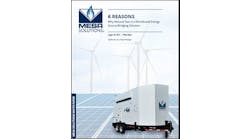As the microgrid industry grows, more and more readers new to the technology come to Microgrid Knowledge looking to learn the basics. So today we’re taking a step back from our usual flow of industry news to offer a compendium of resources that answers five common questions about microgrids.
We offer short explanations for those looking for high level information, and, for those seeking a deeper dive, we provide links to articles, webinars, videos, white papers and special reports. Feel free to send this link to those you know who are beginning to explore microgrids. It might save you a lot of explaining!
1. What are microgrids?
Although microgrids have been around for decades, the technology has matured over the last 10 years and become an important part of energy plans that focus on reliability, sustainability and cost savings. Therefore, more and more people are hearing the term and asking, “What are microgrids?”
Short answer: A microgrid is a local cluster of energy resources within a defined footprint, such as a building, campus or neighborhood. Microgrids keep the power flowing to nearby customers when the central grid fails. They also act as a tool to help energy customers manage costs, participate in energy prosperity and reduce carbon emissions. It’s hard to describe a typical microgrid because they vary by size, depending on the need they serve. They also differ in terms of the kind of power generation they use depending on owner preference, price and availability of resources. A sunny locale may warrant solar panels, for example. A building that needs consistent power, such as a hospital, may include diesel or natural gas generators in its microgrid. Some microgrids have battery storage, others do not.
Longer answer: See definitions provided by Microgrid Knowledge and the US Department of Energy. Take an even deeper dive by watching this microgrid 101 workshop, a tutorial on microgrid technology, operations and uses for those in the early stages of researching microgrids. Learn what a microgrid is, the spectrum of microgrid complexity and what it takes to put a microgrid together.
2. What role do microgrids play during a power outage?
Hurricanes, wildfires and deep freezes can devastate the central electric grid. The US experienced 70% more power outages from 2010-2019 than in the preceding decade. And since then, incidences have mounted that have left millions without power — among them Hurricanes Laura and Ida, Winter Storm Uri in Texas and wildfire-related utility shutoffs in California.
Short Answer: Microgrids keep the power flowing to their customers by islanding or disconnecting from the central grid when it fails. The generation resources within the microgrid — perhaps solar, storage, batteries, wind, natural gas, diesel or combined heat and power — then kick in to provide power to the local customer. In an advanced microgrid, the shift from grid to microgrid happens seamlessly, so that those inside microgrid-protected facilities may be unaware that there is a power outage on the grid. Microgrid Knowledge has extensively covered microgrid performance during power outages. Here are a few articles:
- Facing Off Climate Disaster in Louisiana: The Tale of Two Microgrid Champions
- Hurricane Hanna Demonstrates Value of Microgrids for 30 MW of Texas Load
- Nature Offers Real-Life Drama During Microgrid Tour in Wisconsin
Longer Answer: This ability to connect and disconnect from the grid is what makes a microgrid a microgrid. It’s a unique feature made possible by a smart controller — what’s known as the brain of the microgrid. The controller also manages the various energy resources within the microgrid so that they perform to preset specifications. They may be set, for example, to optimize energy use for lowest price or lowest emissions. Controller sophistication varies widely, so it matters which controller you choose for your microgrid.
To understand microgrids from development through application, listen to the webinar Software & Technology Innovation Showcase or download the white paper How Microgrid Controls Tie Multiple Resources Together.
3. Who uses microgrids?
Short answer: Any operation that benefits from local power, especially those that need their energy to be reliable, clean or cost-effective.
Longer answer: Microgrids are used by a range of entities — communities, hospitals, research universities, businesses, military installations, critical facilities (such as fire stations or water treatment plants), agricultural facilities, airports, ports and transportation systems, government buildings and remote locales. Utilities also install microgrids to augment their systems or serve specific customers.
Even longer answer: Read our article Who Uses Microgrids and Why? for more details on the microgrid value proposition for various industries. Tour a military microgrid virtually by watching Joint Base San Antonio Microgrid Provides Energy Security and Resilience.
Watch this webinar on utility microgrids and this one on health care and microgrids. Here is a video discussion on microgrids in schools. Read these reports on microgrids for retailers, microgrids for data centers and community microgrids.
4. What are the different kinds of microgrids?
Short answer: There are two basic types of microgrids: connected and remote (off-grid). Grid-connected microgrids are common in the United States and other places with a well-established central grid. A grid connection allows the microgrid to buy energy and services from the grid when that’s the best choice; for example, during times of the day when grid prices are low. Conversely, the microgrid can sell power and services to the grid when prices are high or the grid is under strain, providing a revenue stream for the microgrid owner.
Most microgrids are stationary, but there are also mobile microgrids installed on trailers that can be moved to disaster areas or military outposts. Sometimes microgrids are described based on the dominant fuel or technology they use — renewable microgrids, fuel cell microgrids or natural gas-fired microgrids. Modular microgrids are those that can be built in a Lego-like fashion over time as expansion is warranted. Microgrids-in-a-box are partially assembled in the factory for easy installation on-site. Nanogrids are small microgrids that serve one building or house.
Longer answer: Watch this video discussion on remote microgrids, or to get a sense of the advantages of grid-connected microgrids, watch these webinars: How Microgrids Make Money or Load Flexibility: The New Grid Zeitgeist. Read these special reports on fuel cell microgrids, clean energy microgrids, nanogrids and reciprocating engine microgrids.
5. Are microgrids expensive? How do I finance mine?
Short Answer: Microgrids are increasingly being built under energy-as-a-service models, where the host puts no money down, or a small amount, and pays for the services from the microgrid through a monthly charge. Microgrid developers strive to keep the monthly charge below what the customer would pay their local utility for power, but a range of factors can affect the pricing. Under these arrangements, a third party usually owns, operates and maintains the microgrid on behalf of the host. Financing also is widely available under other scenarios, including through leasing.
Longer Answer: Check out these three special reports: The Financial Decision-Makers Guide to Energy-as-a-Service Microgrids, How to Get Your Microgrid Projects Financed and Think Like a Financier to Win Funding for Your Microgrid Project. Watch the webinar How to Finance a Microgrid Project in a Post COVID-19 Economy and the discussion How to Pay for Your Microgrid.
Beyond these five common questions about microgrids
Have more questions about microgrids? Explore Microgrid Knowledge’s extensive white paper and video libraries. Or join us at a Microgrid Knowledge conference.







